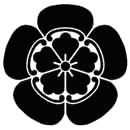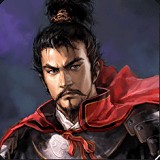

織田 信長
おだ のぶなが
Oda Nobunaga
1534 - 1582
 
Appearances: Sengoku Musou (1,2), Sengoku BASARA (1,2)
Oda Nobunaga was born Oda Kipposhi, the second son of 織田信秀 Oda Nobuhide, the minor
daimyo of the small 尾張 Owari province, He was a very stalwart and brave man, whose
many battles were against the 松平 Matsudaira (later to be named as the Tokugawa) and
Imagawa families of neighboring provinces. The Imagawa were a very noble family
who was centered at a Suruga, while the Matsudaira of Mikawa were very minor
much like the Oda.
During the 1540s, the main powers vying for control on the Owari-Mikawa-Totomi
border were none other than Oda Nobuhide, Matsudaira Hirotada, and Imagawa
Yoshimoto. For the past several years, the Matsudaira had slowly started to
become influenced by the powerful Imagawa clan, so they both naturally supported
one on another. The two allies marched as far west as the Owari border, where
Oda Nobuhide was ready and waiting. The three armies met at the small field of
小豆坂 Azukizaka, where the Oda would take the day. In 1548, Nobuhide attempted to gain
support from the Matsudaira by trying to lure a certain Matsudaira Tadamoto to
his side. However the ploy was revealed and Tadamoto was killed en route to
Nobuhide. To make up for this failure, Nobuhide charged the Matsudaira's main
castle, Okazaki. Though the Imagawa assisted the Matsudaira, Matsudaira Hirotada
was forced to give up his young son 竹千代 Takechiyo (the future Tokugawa Ieyasu) as a hostage
for the Imagawa. However, Nobuhide intercepted the young boy and used it as his
trump card. As luck would have it, the Imagawa and Matsudaira called the bluff.
At the end of 1548, the Oda and Imagawa met on the battlefield, where the Oda
lost. Nobuhide died the following year, leaving the Oda clan and Owari
separated.
The Imagawa wasted no time in taking advantage of Nobuhide's death. A siege at
Anjo castle, where Nobunaga's elder brother was holed up. Unless Nobunaga gave
up the young Takechiyo, his brother would be forced to commit
suicide. Having no other option, Nobunaga sent Takechiyo to the Imagawa and the
siege was put to a halt. By 1551, Nobunaga had become the leader of his Oda
faction and his only enemies were the Iwakura Oda and the Imagawa. By this time,
Nobunaga was early into his adult years. He stood around 5'5'' tall with a
scarce beard and a strong prescence around him. He was a strong speaker and all
together rude at times. In some records, his attitude is what cause the suicide
of a certain 平手清秀 Hirate Kiyohide. Kiyohide committed suicide and left a letter
begging for Nobunaga to change his ways. Years later, Nobunaga would build the
Seisyu-ji temple in honor for his loyal vassal.
By 1558, Nobunaga had secured all of Owari and even defeated the Saito clan to
the north. His only enemy now was the deadly, powerful Imagawa clan. Yoshimoto
was a shrewd politician and his vast amount of able retainers made his army
something to be feared. In 1560, Yoshimoto gathered up around 25,000 troops from
Totomi, Suruga, and Mikawa in a mad push for the capital. Any who did not submit
to the Imagawa clan would be crushed and wiped out all together. Yoshimoto
ordered 松平元康 Matsudaira Motoyasu (The grown-up Takechiyo) to attack the Marume fort. In
the meanwhile, the Imagawa marched into Owari and attacked Washizu castle.
Fortunately, the retainers were able to send word to Nobunaga about the attack
and plans for what course of action the Oda should take went underway. Though
they were divided, Nobunaga took the side of fighting, and gathered enough
Ashigaru and Samurai to give him a larger force. Though his men were outnumbered
at least ten to one by the colossal Imagawa army, Nobunaga was still calm before
the oncoming battle.
The Imagawa army set up camp after the fall of Washizu at the Dengakuhazama
gorge. Yoshimoto was said to have set up his headquarters at the base of a giant
oak tree, and enjoyed Sake and dances while viewing the heads of the fallen Oda
soldiers. Nobunaga went as far as the Narumi Imagawa fort and this was where his
tactical mind went to work. He had flags set up around the hills of Narumi, as
to give the impression to the Imagawa that the Oda were stationed around the
hills. In the meanwhile, Nobunaga moved his troops around the hills to a nearby
one overlooking Yoshimoto's camp. At this point, luck went into play. A giant
summer rainstorm, of which the area was known for, struck the gorge. Taking this
as the perfect sign, Nobunaga gave the order for a charge. Yoshimoto's camp was
dumbstruck as the flowing Oda troops made swept up the Imagawa. Yoshimoto was
killed by a group of Yari (spear) samurai and his head taken. The Imagawa were
left without a trace of morale and fled back to Suruga. The Matsudaira made
haste and returned to Mikawa, free from Yoshimoto's influence.
By 1567, Nobunaga had destroyed the Imagawa and wiped out any Saito threat. The
following year, Nobunaga moved his fort to the newly captured 稲葉山 Inabayama castle
and renamed it as 岐阜 Gifu. Receiving praise from the Emperor, Nobunaga also set up
strong ties with the Matsudaira and the Takeda of Kai. Though the Azai were
somewhat uneasy with Nobunaga's rapid movement into Mino, he quickly made peace
with them by giving the current lord Azai Nagamasa his sister, O-Ichi, as a wife. The plan was all set.
Nobunaga's ambition had begun.
The arrival of Ashikaga Yoshiaki gave Nobunaga even more power. Yoshiaki was the
brother of the late Shogun 足利義輝 Ashikaga Yoshiteru and asked for Nobunaga to assist
him in making his way to the capitol. Nobunaga jumped at the offer and set out
for Kyoto in 1568. Nobunaga would become displease with the Shogunate eventually
and declined several high-ranking political titles.
In the early 1570s, Nobunaga's aim for ruling the land was closer to becoming a
reality. He had all of central Japan under his sphere of influence and was
dealing with his enemies (The 一向一揆 Ikko-Ikki warrior monks, to name specifics) quite
easily. His first real test of power and authority came in 1570. After accusing
Asakura Yoshikage for dis-loyalty to the Shogun and Emperor, Nobunaga marched
his troops (With the help of Tokugawa Ieyasu, the former Matsudaira Motoyasu)
into Echizen and declared war on the 朝倉 Asakura. Much to the dismay of Nobunaga,
however, Azai Nagamasa, Nobunaga's brother in law, broke his alliance to the Oda
and supported his long time allies the Asakura. After some small struggles and
battles with the Azai-Asakura, Nobunaga and Ieyasu met the two at the river
field of Anegawa in July of 1570. The Azai-Asakura were defeated at Anegawa,
yes, but the struggle for power had just begun. The Azai and Asakura continued
to attack Nobunaga's troops to the north, while the hordes of Monk forces
plagued the Oda's central area. There were also rumors that the current Shogun
was plotting against his former patron as well. In 1571, however, Nobunaga cut
all ties the shogun had with other daimyo and left him sitting in his Kyoto
palace with not a thread of authority.
Nobunaga, under threat from dozens of clans and warriors in the anti-Oda
alliance, lashed out in late 1571. Nobunaga's forces surrounded 比叡山 Mt. Hiei and launched a genocide,
proceeding to slaughter every monk, women, and child. Nobunaga had the whole mountain side burned and the Mt. Hiei sect was destroyed. From this misdeed, Nobunaga gained his infamous title of 第六天魔王 Dairokuten Ma-ou (Sixth Sky Devil King).
Responding to this, the Takeda marched into Tokugawa lands and threatened
Ieyasu. Making a wise decision, Nobunaga sent some of his troops to help support
Ieyasu, though ultimately this would prove fatal as the Tokugawa were nearly
wiped out at Mikatagahara.
The death of Takeda Shingen halted the Takeda advance significantly. However,
武田勝頼 Takeda Katsuyori, Shingen's heir, picked up where his father left off and
intended to bring back the glory of the Takeda. In May of 1575, he pushed his
way to Nagashino castle in Totomi. Nobunaga hesitated at first to help the small
Tokugawa, but he made yet another wise decision and went to Nagashino. The
combined force of the Oda-Tokugawa alliance was more than 38,000 men plus 3,000
rifle troops. In on June 28th, Katsuyori had failed to order a retreat and
instead ordered a full on charge against the Oda-Tokugawa men. However, this
charged was doomed to fail. The 10,000 Takeda Calvary had to go through
unfavorable terrain, wooden barriers which Nobunaga had erected earlier, and
thousands of rifle units. Using a system of continuous fire, the rifle units
wiped out the majority of Katsuyori's charge, while the Oda Ashigaru rushed the
field and butchered any Calvary who remained. The Takeda were wiped out, and
Katsuyori got away while some of the greatest Takeda generals were slaughtered.
This was one of the most significant battles in Nobunaga's life, and the worst
for the Takeda.
In the last years of his life, Nobunaga had nearly united all of Honshu but the northern region of Oushuu and western region of Chugoku. His
only enemies now were the remaining Monk factions, the Uesugi to the north, and Mouri to the west. Though
he would lose to the Uesugi at Tedorigawa, Kenshin passed away shortly after
leaving only one direction for Nobunaga to focus on. While Nobunaga would deal
with the Ikko in central Honshu, which he would wipe out in 1580, he sent out
some of his ablest generals to start the conquering of the west. Having ordered
Akechi Mitsuhide to secure Tamba and Hashiba (Later Toyotomi) Hideyoshi to
control Harima, Nobunaga's dream was even closer at hand. By 1582, he had
destroyed the remaining Takeda and Hideyoshi was on his way to the Mouri
homelands. Nobunaga was now on the seat of power, sans for one threat not even
Nobunaga could have guessed.
Nobunaga was known for his cruel ways, which didn't stop short of his enemies.
He was noted to have been very harsh to his vassals as well, most notably Akechi
Mitsuhide. Nobunaga was said to have publicly mocked Mitsuhide for his bald head
and was angered at Mitsuhide's skill in poetry. Though if theses were the
reasons that would lead to Mitsuhide's rebellion, it is still unknown. After
securing Tamba, instead of marching to Hideyoshi's aid per Nobunaga's order,
Mitsuhide ordered for a turn around. His target: Honnouji, Nobunaga's place of
residence in Kyoto. On the morning of June 21st, 1582, Nobunaga awoke to the
sounds of gun shots and the sight of the purple bellflower, Mitsuhide's crest.
Nobunaga's fate was sealed. He would perish in the flames of the burning
Honnouji, and his eldest son killed. The man known as Nobunaga perished with his
dreams on that one day.
| | |